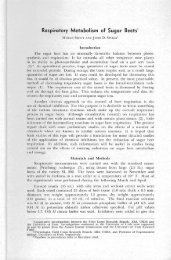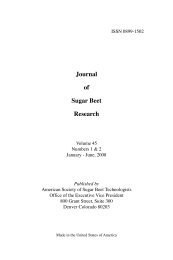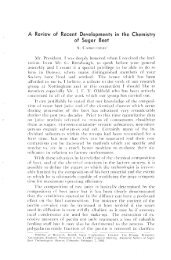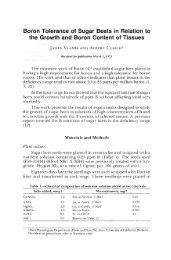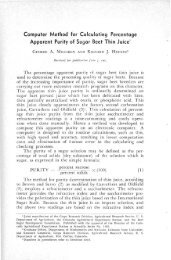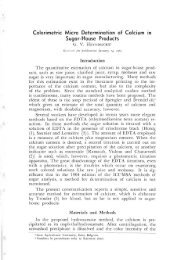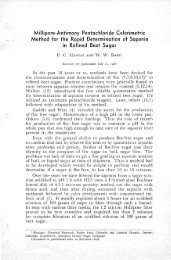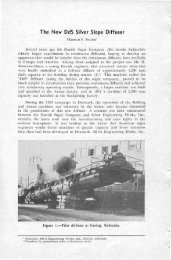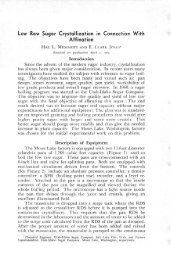To Phoma Betae and Rhizoctonia Solanf - Vol
To Phoma Betae and Rhizoctonia Solanf - Vol
To Phoma Betae and Rhizoctonia Solanf - Vol
Create successful ePaper yourself
Turn your PDF publications into a flip-book with our unique Google optimized e-Paper software.
July - December 1989 Seedling Response of Storage-Rot-Resistant Sugar Beets<br />
Seedling Response of<br />
Storage-Rot-Resistant Sugar Beets<br />
<strong>To</strong> <strong>Phoma</strong> <strong>Betae</strong> <strong>and</strong> <strong>Rhizoctonia</strong> <strong>Solanf</strong><br />
W. M. Bugbee, L. G. Campbell <strong>and</strong> M. EI-Kholi<br />
Plant Pathologist <strong>and</strong> Plant Geneticist, U. S. Department of Agriculture,<br />
Agricultural Research Service,<br />
Northern Crop Science Laboratory, Fargo ND 58105<br />
<strong>and</strong> Plant Pathologist, Sugar Crops Research Institute,<br />
Giza, Egypt<br />
ABSTRACT<br />
Five sugar beet germplasm lines resistant to storage<br />
rot caused by <strong>Phoma</strong> betae also were resistant to<br />
<strong>Phoma</strong> damping-off in the seedling stage. Seedling<br />
resistance to P. betae was not significantly affected<br />
at 15° or 25OC. Seedlings resistant to P. betae were not<br />
resistant to AG-2-2 or AG-4 of <strong>Rhizoctonia</strong> solani.<br />
Thus, genetic resistance to <strong>Phoma</strong> damping-off disease,<br />
but not <strong>Rhizoctonia</strong> damping-off, can be<br />
selected when mature harvested roots are evaluated<br />
for resistance to <strong>Phoma</strong> storage rot.<br />
Additional Key Words: Seedling disease; seedling disease resistance;<br />
black leg<br />
Rot of stored sugar beet (Beta vulgaris L.) occurs<br />
even if roots are stored properly. Primary causes are the fungal<br />
pathogens <strong>Phoma</strong> betae Frank (teleomorph, Pleospora bjorlingii<br />
Byford), Botrytis cinerea, <strong>and</strong> Penicillium spp. <strong>Phoma</strong> betae is the<br />
most significant of these pathogens because it affects all life cycle<br />
phases of sugar beet <strong>and</strong> causes seedling disease, crown rot, leaf<br />
spot, <strong>and</strong> storage rot (Edson, 1915; Byford, 1972; <strong>To</strong>mkins <strong>and</strong><br />
Pack, 1932). Also, it is the only recognized seed-borne fungal<br />
pathogen of sugar beet (Edson, 1915). This fungus causes storage<br />
losses of thous<strong>and</strong>s of tons of sucrose per year (Bugbee <strong>and</strong><br />
Cole, 1976). Valuable germplasm can be lost when stored mother<br />
roots are destroyed by <strong>Phoma</strong> rot. Breeding lines with resistance<br />
to this pathogen have been developed (Bugbee, 1978; Campbell<br />
Cooperative investigation of the U.S. Department of Agriculture <strong>and</strong> North<br />
Dakota Agricultural Experiment Station. Published with approval of the Director<br />
of the North Dakota Agricultural Experiment Station as Journal Series Article<br />
1786. Requests for reprints should be sent to W. M. Bugbee, USDA-ARS, Northern<br />
Crop Science Laboratory, P.O. Box 5677, Fargo, ND 58105-5677.<br />
33
34 Journal of Sugar Beet Research <strong>Vol</strong> 26 No 3 & 4<br />
<strong>and</strong> Bugbee, 1985).<br />
<strong>Rhizoctonia</strong> solani Kuehn (teleomorph, Thanatephoris cucumeris<br />
[Frank] Donk) causes seedling disease, crown <strong>and</strong> root rot, <strong>and</strong><br />
foliar blight, but not storage rot. Germplasm lines resistant to<br />
<strong>Rhizoctonia</strong> root rot have been developed <strong>and</strong> some have shown<br />
resistance in the seedling stage (Campbell <strong>and</strong> Altman, 1976;<br />
Ruppel, 1972; Bugbee, unpublished data). One root rot resistant<br />
germplasm line <strong>and</strong> selections from it also were resistant to storage<br />
rot caused by P. betae (Bugbee, 1979a). Therefore, R. solani<br />
was included in this study to determine whether storage-rotresistant<br />
lines also might be resistant to R. solani in the seedling<br />
stage.<br />
Low levels of resistance to <strong>Phoma</strong> storage rot (Bugbee, 1973)<br />
<strong>and</strong> to <strong>Phoma</strong> damping-off exist among cultivars (Osinka, 1985).<br />
Whether resistance to both phases of the disease resides within<br />
the same cultivar has not been reported.<br />
The objectives of this research were: 1) to determine whether<br />
storage rot <strong>and</strong> damping-off resistance to P. betae occurred in the<br />
same germplasm line; 2) to determine whether temperature affected<br />
a genotypic response to <strong>Phoma</strong> damping-off; <strong>and</strong> 3) to<br />
detect seedling resistance to <strong>Rhizoctonia</strong> solani in germplasm lines<br />
resistant to <strong>Phoma</strong> storage rot.<br />
MATERIALS AND METHODS<br />
Roots used for storage rot evaluations were grown in a Fargo<br />
clay soil type at the North Dakota Agricultural Experiment Station,<br />
Fargo. Harvested roots were washed, stored at 4-6°C <strong>and</strong><br />
95% relative humidity in perforated plastic bags, <strong>and</strong> evaluated<br />
for resistance to P. betae within 90 days. The inoculum for storage<br />
rot evaluations was prepared by adding 1 ml of a conidial suspension<br />
of a 2- to 3-wk-old culture of P. betae to 20 ml molten (50°C)<br />
potato-dextrose agar amended with 30 p,g/ml of streptomycin<br />
sulfate, which was then poured to 10-cm square, sterile, polystyrene<br />
disposable Petri dishes. The cultures were incubated until<br />
the agar surface was covered with mycelium (usually 4 days);<br />
then 1-cm cubes were prepared (Bugbee, 1979b) from field-grown<br />
roots <strong>and</strong> placed (cut surface down) on the cultures <strong>and</strong> incubated<br />
for 14 days at 22°C. Forty- nine cubes were placed in each dish<br />
in a sequential order so that each cube could be identified with<br />
its numbered, parent root. After incubation, the cubes were cut<br />
in half <strong>and</strong> assigned a storage rot rating based on the distance<br />
rot had progressed through the cube: 0 = no rot; 1 = not over<br />
2 mm; 2 = 2-4 mm; 3 = 4-6 mm; 4 = 6-8 mm; <strong>and</strong> 5 = completely<br />
rotted.<br />
Seedling Response to P. betae. Two germplasm lines that were<br />
developed for storage rot resistance to P. betae (Bugbee, 1978),<br />
F10m (Reg. No. GP-15) <strong>and</strong> F1002 (Reg. No. GP-16), were compared<br />
to the susceptible cultivar American Crystal 2B <strong>and</strong> the<br />
susceptible germplasm line PBP-4 for seedling resistance. The<br />
germplasm line F1001 was selected from an introduction from
July - December 1989 Seedling Response of Storage-Rot-Resistant Sugar Beets<br />
the Soviet Union <strong>and</strong> F1002 was selected from FC 701/4, a line<br />
developed for resistance to R. solani by USOA-ARS at Fort Collins,<br />
Colorado.<br />
The inoculum for seedling evaluation was prepared by growing<br />
P. betae on green bean agar (GBA) for 10-15 days under light<br />
at 23°C. The GBA was prepared by heating 150 g of snap bean<br />
(Phaseolus vulgaris L.) pods for 30 min at 60°C in 500 ml of distilled<br />
water (OW). The bean extract was brought to 1 L by the addition<br />
of OW, 20 g of agar was added, <strong>and</strong> the mixture was autoclaved<br />
for 20 min at 121°C. Conidia were collected by flooding cultures<br />
with sterile OW <strong>and</strong> then lightly scraping the agar surface with<br />
a spatula to dislodge the conidia. The conidial concen- tration<br />
was adjusted to 5 x 10 s /ml with the aid of a cell counter. Seed<br />
were inoculated by submerging them in a conidial suspension<br />
for 30 min <strong>and</strong> then incubating the moist seed for 24 h at room<br />
temperature <strong>and</strong> 100% relative humidity before planting. Control<br />
seeds were submerged in OW.<br />
<strong>To</strong> evaluate seedling reaction to P. betae, inoculated seeds of<br />
each germplasm line were planted in flats (34 x 49 cm with a<br />
capacity of 10 L) containing pasteurized s<strong>and</strong> <strong>and</strong> grown in a<br />
growth chamber at 22°C <strong>and</strong> 14-h light period with a mix of<br />
fluorescent <strong>and</strong> inc<strong>and</strong>escent light (18,300 lux). Treatments (25<br />
seeds of each line) were arranged in a r<strong>and</strong>omized complete<br />
block design <strong>and</strong> replicated four times. St<strong>and</strong> counts were taken<br />
when the second leaf emerged <strong>and</strong> were expressed as percent<br />
emergence of uninoculated controls. An analysis of variance was<br />
performed on arcsine transformed percentages.<br />
Effect of Temperature on Seedling Response to P. betae. Three<br />
germplasm lines, F1004 (Reg. No. GP-94), F1005 (Reg. No. GP-95),<br />
<strong>and</strong> F1006 (Reg. No. GP-96), with improved storage rot resistance<br />
were compared with three other germplasm liness for seedling<br />
resistance to P. betae. The germplasm lines F1004 <strong>and</strong> F1005 were<br />
selected from introductions from the Soviet Union, <strong>and</strong> F1006<br />
was selected from a population of resistant individuals from the<br />
USOA-ARS Beta collection (Campbell <strong>and</strong> Bugbee, 1985). Three<br />
other germplasm lines that were used in this experiment were<br />
not tested for storage rot resistance. They were 85N0016 which<br />
had been developed for high sucrose content, 85N0030 developed<br />
for low storage respiration rate, <strong>and</strong> M-1 developed for<br />
resistance to the sugar beet root maggot (Tetanops myopaeformis).<br />
Ten seeds per germplasm line were planted in 15-cm clay pots<br />
containing commercial, pasteurized Sunshine Mix No.1 (Fisons<br />
Western Corp., Vancouver, B.C., Canada) <strong>and</strong> grown at 15° or<br />
25° in four replicates as in the previously described seedling<br />
experiement. After st<strong>and</strong> counts were taken, surviving seedlings<br />
were harvested <strong>and</strong> the leaves <strong>and</strong> stems were removed <strong>and</strong><br />
discarded. Hypocotyls <strong>and</strong> roots were surface-disinfested in 0.1 %<br />
sodium hypochlorite for 30 s, rinsed twice in sterile OW, plated<br />
on an agar medium selective for P. betae (Bugbee, 1974), <strong>and</strong><br />
incubated at 23°C under constant fluorescent light for 10-12 days.<br />
35
36 Journal of Sugar Beet Research <strong>Vol</strong> 26 No 3 & 4<br />
The number of infected seedlings were counted <strong>and</strong> the identity<br />
of P. betae was confirmed by the presence of characteristic<br />
holdfasts that formed at the bottom surface of the culture dish<br />
(Mangan, 1971; Bugbee, 1974). Data were modified by substracting<br />
counts of the uninoculated treatments from counts of inoculated<br />
treatments. The three resistant lines, as a group, <strong>and</strong> the<br />
susceptible lines, as a group, were compared by linear contrast.<br />
Response of Seedlings to R. solani. Resistance in germplasm<br />
lines F1004, F1005, F1006, M-1, 85N0016, <strong>and</strong> 85N0030 was tested<br />
against local field isolates of R. solani from anastomosis groups<br />
4 <strong>and</strong> 2-2. The test was conducted at 20° or 25°C because of an<br />
earlier report of seedling resistance being expressed at 26°C<br />
(Campbell <strong>and</strong> Altman, 1976). Barley was soaked overnight in<br />
1 % potato-dextrose broth, drained, <strong>and</strong> 250 ml were placed in<br />
1 L Erlenmeyer flasks. The barley was sterilized by autoclaving<br />
twice for 1 h at a one-day interval. Each flask was inoculated<br />
with one-fourth of a young <strong>Rhizoctonia</strong> Petri dish culture that<br />
had grown to about 9 cm in diameter. The fungus was grown<br />
on the sterile barley at 25°C for 2 wk, air-dried, <strong>and</strong> ground in<br />
a hammer mill to pass through a screen with 3-mm diameter<br />
openings. Ground barley inoculum containing 500 or 2500 propagules<br />
of R. solani was uniformly mixed into the potting soil that<br />
was used to cover the seed, The inoculum level was determined<br />
from counts of colonies that grew from known weights of ground<br />
barley on the selective medium of Ko <strong>and</strong> Hora (1971). St<strong>and</strong><br />
counts were taken when the second leaf emerged.<br />
RESULTS<br />
Seedling Response to P. betae. The level of storage rot resistance<br />
among the four germplasm lines in the first experiment is shown<br />
in Table 1 (Bugbee, 1978). The storage rot ratings were taken<br />
from previous work (Bugbee, 1978) where the ratings of 2.4 for<br />
both F1001 <strong>and</strong> F1002 were significantly lower than the rating of<br />
4.1 for hybrid 2B (LSD.os = 0.09). The rating for germplasm line<br />
PBP-4 was from a separate evaluation <strong>and</strong> was not included in<br />
the analysis of variance. F1001 expressed resistance to P. betae<br />
damping-off as shown by a st<strong>and</strong> count only 3% less than the<br />
uninoculated control. The seedling response of F1002 to P. betae<br />
also was favorable but not statistically different from susceptible<br />
PBP-4 or 2B. Figure 1 shows representative seedling damage<br />
caused by P. betae to the storage-rot-resistant germplasm F1001<br />
<strong>and</strong> the susceptible cultivar 2B.<br />
Effect of Temperature on Seedling Response to P. betae. More<br />
seedling disease occurred at 25° than at 15°C, but ranking of the<br />
genotypes with respect to resistance to seedling disease remained<br />
the same <strong>and</strong> the temperature X germplasm line interaction was<br />
not significant, so data for the two temperatures were combined<br />
(Figure 2). Natural infection of beet seed with P. betae is common<br />
(Byford, 1972; Edson, 1915). Osinka (1985) reported that differential<br />
resistance among 25 inoculated cultivars was obscured by
July - December 1989 Seedling Response of Storage-Rot-Resistant Sugar Beets<br />
were developed for resistance to <strong>Phoma</strong> storage rot also possessed<br />
resistance to P. betae damping-off <strong>and</strong> resulted in reduced<br />
st<strong>and</strong> loss <strong>and</strong> fewer infected seedlings. The results of our research<br />
indicate that genetic resistance to seedling infection by P.<br />
betae can be developed <strong>and</strong> should be considered as a complement<br />
to fungicidal seed treatments for seedling disease control,<br />
especially in those regions of the world where <strong>Phoma</strong> seedling<br />
disease is important.<br />
Mention of a trademark, proprietary product, or vendor does<br />
not constitute a guarantee or warranty of the product by the<br />
USDA <strong>and</strong> does not imply its approval to the exclusion of other<br />
products that may also be suitable.<br />
LITERATURE CITED<br />
Bugbee, W. M. 1973. Resistance in Beta vulgaris to phoma storage rot in the north<br />
central region. Plant Dis. Rptr. 57:204-207.<br />
Bugbee, W. M. 1974. A selective medium for the enumeration <strong>and</strong> isolation of<br />
<strong>Phoma</strong> betae from soil <strong>and</strong> seed. Phytopathology 64:706-708.<br />
Bugbee, W. M. 1978. Registration of FlO01 <strong>and</strong> Fl002 sugarbeet germplasm. Crop<br />
Sci. 18:358.<br />
Bugbee, W. M. 1979a. Resistance to sugar beet storage rot pathogens. Phytopathology<br />
69:1250-1252.<br />
Bugbee, W. M. 1979b. The effect of plant age, storage, moisture, <strong>and</strong> genotype<br />
on storage rot evaluation of sugar beet. Phytopathology 69:414-416.<br />
Bugbee, W. M. <strong>and</strong> D. F. Cole. 1976. Sugar beet storage rot in the Red River<br />
Valley, 1974-1975. J. Am. Soc. Sugar Beet Techno!. 19:19-24.<br />
Byford, W. J. 1972. The incidence of sugar beet seedling diseases <strong>and</strong> effects of<br />
seed treatment in Engl<strong>and</strong>. Plant Pathol. 21:16-19.<br />
Campbell, C. L. <strong>and</strong> J. Altman. 1976. Rapid laboratory screening of sugar beet<br />
cultivars for resistance to <strong>Rhizoctonia</strong> solani. Phytopathology 66:1373-1374.<br />
Campbell, L. G. <strong>and</strong> W. M. Bugbee. 1985. Registration of storage rot resistant<br />
germplasms FlO04, Pl005, <strong>and</strong> FlO06. Crop Sci. 25:577.<br />
Edson, H. A. 1915. Seedling disease of sugar beets <strong>and</strong> their relation to root-rot<br />
<strong>and</strong> crown-rot. J. Agric. Res. 4:135-168.<br />
Ko, W. H. <strong>and</strong> F. K. Hora. 1971. A selective medium for the quantitative determination<br />
of <strong>Rhizoctonia</strong> solani in soil. Phytopathology 61: 707- 710.<br />
Mangan, A. 1971. New method for the detection of Pleospora bjoerlingii infection<br />
of sugar beet seed. Trans. Brit. Mycol. Soc. 57:169-172.<br />
Osinka, B. 1985. Investigation of the testing for black leg resistance in sugarbeet.<br />
1. Resistance to <strong>Phoma</strong> betae. B. Inst. Hod. Akl. Ros. 157:161-166.<br />
Ruppel, E. G. 1972. Correlation of cultural characters <strong>and</strong> source of isolates with<br />
pathogenicity of <strong>Rhizoctonia</strong> solani from sugar beet. Phytopathology 62:202<br />
205.<br />
<strong>To</strong>mkins, C. M. <strong>and</strong> D. A. Pack. 1932. Effect of temperature on rate of decay of<br />
sugar beets by strains of <strong>Phoma</strong> betae. J. Agric. Res. 44:29- 37.<br />
39



